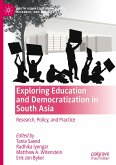Towards Ensuring Inclusive and Equitable Quality Education for All
Analyzing School Enrolment Patterns
Herausgegeben:Sekiya, Takeshi; Ogawa, Keiichi; Kitamura, Yuto; Ashida, Akemi
Towards Ensuring Inclusive and Equitable Quality Education for All
Analyzing School Enrolment Patterns
Herausgegeben:Sekiya, Takeshi; Ogawa, Keiichi; Kitamura, Yuto; Ashida, Akemi
- Gebundenes Buch
- Merkliste
- Auf die Merkliste
- Bewerten Bewerten
- Teilen
- Produkt teilen
- Produkterinnerung
- Produkterinnerung
This edited volume builds upon a rich literature base on quality, equity, and education for all. It focuses on enrolment patterns in education and includes extensive, micro-level analytical data to support their findings. The chapters include evidence-based analytical methods with three global regions and eleven country case studies that contribute to the United Nation's Sustainable Development Goal 4 (SDG 4) Quality Education for All by 2030. The book offers valuable and practical learning materials for policymakers, field practitioners, researchers and research students specializing in…mehr
Andere Kunden interessierten sich auch für
![Exploring Education and Democratization in South Asia Exploring Education and Democratization in South Asia]() Exploring Education and Democratization in South Asia104,99 €
Exploring Education and Democratization in South Asia104,99 €![Quality and Inclusive Education Quality and Inclusive Education]() Kennedy OtienoQuality and Inclusive Education52,99 €
Kennedy OtienoQuality and Inclusive Education52,99 €![Towards an Effective School Improvement Model Towards an Effective School Improvement Model]() Ahmed AlKoofiTowards an Effective School Improvement Model74,99 €
Ahmed AlKoofiTowards an Effective School Improvement Model74,99 €![Teachers Perception towards Pupils with Low Vision Teachers Perception towards Pupils with Low Vision]() Justice Ampofo AgyeiTeachers Perception towards Pupils with Low Vision33,99 €
Justice Ampofo AgyeiTeachers Perception towards Pupils with Low Vision33,99 €![The Emergence of the Ethically-Engaged University The Emergence of the Ethically-Engaged University]() The Emergence of the Ethically-Engaged University123,99 €
The Emergence of the Ethically-Engaged University123,99 €![Proposals on the Concept of Quality Higher Education Proposals on the Concept of Quality Higher Education]() Mauro Guzmán LemusProposals on the Concept of Quality Higher Education30,99 €
Mauro Guzmán LemusProposals on the Concept of Quality Higher Education30,99 €![Equitable and Inclusive Education for All? Equitable and Inclusive Education for All?]() James MedwayEquitable and Inclusive Education for All?40,99 €
James MedwayEquitable and Inclusive Education for All?40,99 €-
-
-
This edited volume builds upon a rich literature base on quality, equity, and education for all. It focuses on enrolment patterns in education and includes extensive, micro-level analytical data to support their findings. The chapters include evidence-based analytical methods with three global regions and eleven country case studies that contribute to the United Nation's Sustainable Development Goal 4 (SDG 4) Quality Education for All by 2030. The book offers valuable and practical learning materials for policymakers, field practitioners, researchers and research students specializing in comparative education, international educational development, and international cooperation.
Produktdetails
- Produktdetails
- International and Development Education
- Verlag: Palgrave Macmillan / Springer Nature Switzerland / Springer, Berlin
- Artikelnr. des Verlages: 978-3-031-70265-5
- Seitenzahl: 400
- Erscheinungstermin: 10. November 2024
- Englisch
- Abmessung: 216mm x 153mm x 26mm
- Gewicht: 605g
- ISBN-13: 9783031702655
- ISBN-10: 3031702654
- Artikelnr.: 71320672
- Herstellerkennzeichnung Die Herstellerinformationen sind derzeit nicht verfügbar.
- International and Development Education
- Verlag: Palgrave Macmillan / Springer Nature Switzerland / Springer, Berlin
- Artikelnr. des Verlages: 978-3-031-70265-5
- Seitenzahl: 400
- Erscheinungstermin: 10. November 2024
- Englisch
- Abmessung: 216mm x 153mm x 26mm
- Gewicht: 605g
- ISBN-13: 9783031702655
- ISBN-10: 3031702654
- Artikelnr.: 71320672
- Herstellerkennzeichnung Die Herstellerinformationen sind derzeit nicht verfügbar.
Takeshi Sekiya is Professor in the School of International Studies at Kwansei Gakuin University, Japan. Keiichi Ogawa is Professor and Department Chair in the Graduate School of International Cooperation Studies at Kobe University, Japan. Yuto Kitamura is Professor in the Graduate School of Education at The University of Tokyo, Japan. Akemi Ashida is Associate Professor in the Graduate School of International Development at Nagoya University, Japan.
Chapter 1: Introduction.- Part I: Traditional approaches to children's school enrolment analyses: The overview of the regional cross-sectional approach.- Chapter 2: Challenges for providing quality education in Central America: Lessons from the achievements of the past four decades.- Chapter 3: Notable progress and prospective challenges in diverse regions of South and Southeast Asia.- Chapter 4: Access or quality? New challenges in Sub-Saharan Africa.- Part II: Country case studies: Findings from enrolment pattern analysis.- Chapter 5: Who has still been left behind? A comparative analysis of children's enrolment patterns in different geographical areas of Honduras.- Chapter 6: Changes in female primary and secondary school enrolment in El Salvador since the early 1980s.- Chapter 7: Barriers to completion of basic education: Individual children's actual enrolment status in Nepal.- Chapter 8: Analysis of enrolment patterns in Myanmar's primary education by socioeconomic status.- Chapter 9: Impact of 'ethnic affinity' between teachers and children on enrolment status: Evidence from the northern Lao PDR.- Chapter 10: Examining student enrolment patterns: Case of lower secondary school in Siem Reap, Cambodia.- Chapter 11: Analysis of student retention in primary education level under Mongolia's automatic promotion policy.- Chapter 12: Educational strategies of children living in a developing country: A longitudinal school record study of Malawi secondary schools.- Chapter 13: Analysis of students' flow patterns from primary through lower secondary cycle under automatic promotion policy in Uganda.- Chapter 14: Individual learners' enrolment status in primary and secondary education: A case study of a rural city in Zambia.- Part III: International comparative analysis: Factors preventing children from enrolment.- Chapter 15: Common enrolment patterns, grade repetition and unique cases: International comparative analysis on enrolment status.- Chapter 16: Lessons from Japanese educational development experiences: Comparison of enrolment status between developing countries and the Meiji of Japan.- Chapter 17: Conclusion: Prospects and implications from individual children's school enrolment analysis.
Chapter 1: Introduction.- Part I: Traditional approaches to children's school enrolment analyses: The overview of the regional cross-sectional approach.- Chapter 2: Challenges for providing quality education in Central America: Lessons from the achievements of the past four decades.- Chapter 3: Notable progress and prospective challenges in diverse regions of South and Southeast Asia.- Chapter 4: Access or quality? New challenges in Sub-Saharan Africa.- Part II: Country case studies: Findings from enrolment pattern analysis.- Chapter 5: Who has still been left behind? A comparative analysis of children's enrolment patterns in different geographical areas of Honduras.- Chapter 6: Changes in female primary and secondary school enrolment in El Salvador since the early 1980s.- Chapter 7: Barriers to completion of basic education: Individual children's actual enrolment status in Nepal.- Chapter 8: Analysis of enrolment patterns in Myanmar's primary education by socioeconomic status.- Chapter 9: Impact of 'ethnic affinity' between teachers and children on enrolment status: Evidence from the northern Lao PDR.- Chapter 10: Examining student enrolment patterns: Case of lower secondary school in Siem Reap, Cambodia.- Chapter 11: Analysis of student retention in primary education level under Mongolia's automatic promotion policy.- Chapter 12: Educational strategies of children living in a developing country: A longitudinal school record study of Malawi secondary schools.- Chapter 13: Analysis of students' flow patterns from primary through lower secondary cycle under automatic promotion policy in Uganda.- Chapter 14: Individual learners' enrolment status in primary and secondary education: A case study of a rural city in Zambia.- Part III: International comparative analysis: Factors preventing children from enrolment.- Chapter 15: Common enrolment patterns, grade repetition and unique cases: International comparative analysis on enrolment status.- Chapter 16: Lessons from Japanese educational development experiences: Comparison of enrolment status between developing countries and the Meiji of Japan.- Chapter 17: Conclusion: Prospects and implications from individual children's school enrolment analysis.








